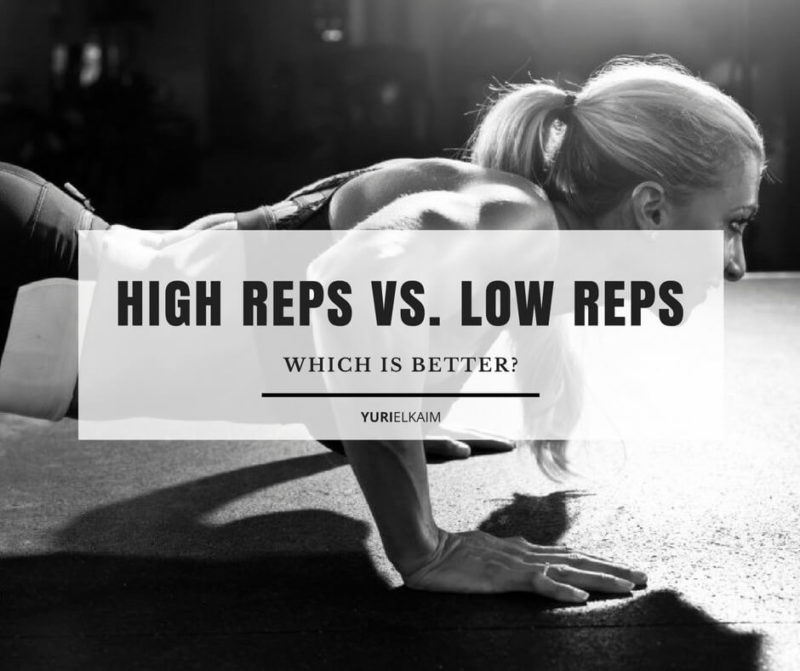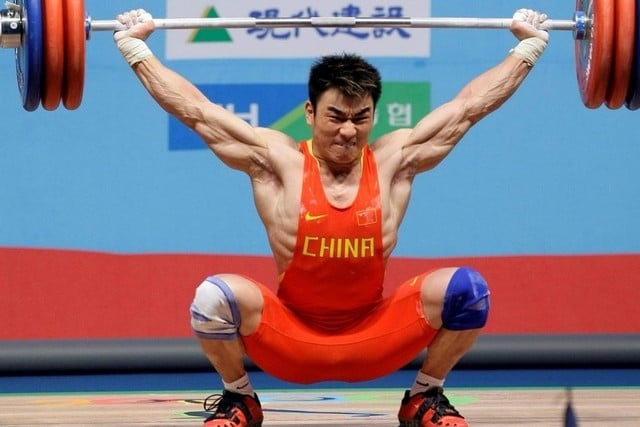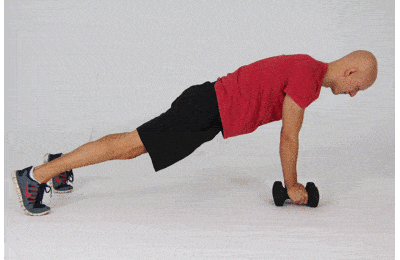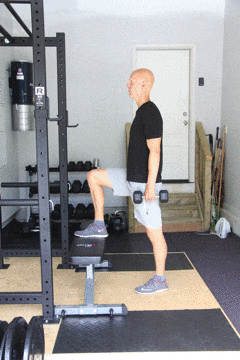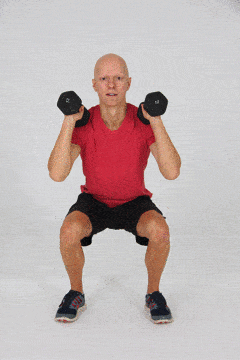In this article
High reps vs. low reps. This long-standing debate seems like it will never go away.
There’s so much conflicting information out there, it’s sometimes a wonder we can step away from the bickering over “what’s better” long enough to actually get in a workout.
First, let’s lay the foundation of the argument. Boiled down, weight training comes in a basic two-form approach, with people arguing over which is better:
- Heavy weight lifting with low reps or
- Lighter weight lifting with higher reps.
Just looking at these two options, you might be wondering, “Okay, so what’s the big deal?”
The big deal happens whenever anyone tries to decide which is more effective for weight loss and fitness goals.
Below I’ll explain this argument, and tell you which is truly the best for losing weight based on science.
High Reps vs. Low Reps
When you first start your quest to get into shape and lose weight, it’s easy to get confused right out of the gate. Why? Because there’s so much information floating through the fitness world, and a lot of it contradicts itself.
Some say high-rep exercises help you (most especially women) get toned without “bulking,” while others say high reps aren’t going to do much for you in terms of fat loss and that you should always lift heavy.
So which is the truth?
Well, for one, when most people hear “lifting heavy” they imagine an Olympic lifter bench-pressing or squatting an obscene amount of weight in the gym, grimacing in pain and grunting with effort.
Seriously: does that look like much fun? It’s no wonder most people want nothing to do with that, and pick up a 5-pound dumbbell instead.
Which is too bad, because the truth is that lifting heavy means lifting a weight that is challenging for you. Ideally, a weight you can only lifting for 6 to 8 repetitions with proper form.
It’s also unfortunate because lifting heavy is one of the best ways to turn your body into a fat-burning machine – and it’s much more effective than doing high-rep workouts.
Will You Build Big Muscles?
To address the second concern about lifting heavy, especially for women: no, women will not get “bulky” from lifting a challenging weight. They simply do not produce enough testosterone to become too muscular.
In fact, heavy lifting (or challenging lifting) will create nice muscle tone, while high reps will most likely leave you unchanged and unchallenged – a bad place for weight loss when it comes to staying motivated.
The fact is, the only time high reps may help in weight loss is if they’re structured into a high-intensity interval training workout. For instance, jump squats or other exercises that you have to perform within a time limit.
Even so, if you’re easily performing dozens of reps, you should probably add some type of weight or resistance to make the exercise more challenging.
An important note: if you’re a complete beginner, you’ll most likely (and more safely) start out with higher-rep bodyweight exercises to get in shape before picking up the weights.
The Benefits of Lifting Heavy
Now that we know that lifting heavy weight with low reps can help us lose fat, lets take a look at why.
Heavy Weights Boost Metabolism
Many people trying to lose fat jump on the nearest treadmill in order to “burn calories.”
Sure, they’ll burn a decent number of calories in the short term doing hours of steady-state cardio. But the kicker is just that: these calories are only being burned in the short term.
When you look at steady-state cardio’s effect on metabolism, well, there really isn’t much to look at. If anything, excess cardio has been shown to raise cortisol levels (the body’s “stress” hormone) and may have a negative effect on metabolism (1).
Not to mention, too much steady-state cardio lowers testosterone and HGH (human growth hormone) levels. These hormones are the premiere hormones that promote synthesis of protein tissues and help your body use stored fat for energy (2).
This is only bad news for your body when it comes to burning fat, it can also cause fatigue, hot flashes, irritability, decreased muscle mass, and bone density.
High-rep weight training workouts aren’t that much different than steady-state cardio. You’re essentially “burning” calories in the short term through activity, but the question remains: what about the long term?
This is where heavy lifting takes the win.
How to Burn Fat Post-Workout:
Far from having a negative effect on metabolism, lifting heavy with a high intensity increases metabolism for days following the actual workout.
For instance, one study published in the European Journal of Applied Physiology found that a 31-minute compound exercise workout boosted exercisers metabolisms for an astounding 48 hours following the workout (3).
This occurs due to a phenomenon referred to as excess post-exercise oxygen consumption, or EPOC.
EPOC is the amount of energy we use (or calories we burn) after a workout, rather than during.
To explain the workings of EPOC in simple terms, intense workouts including heavy resistance cause you to become breathless and feel an intense burn in your muscles. This results from depleted oxygen levels in your cells and the buildup of lactic acid in your muscles.
After your workout, your body works harder to restore these oxygen levels and clear out excess lactic acid (not to mention repair your muscles) – all of which increase post-exercise calorie burn.
An elevated calorie burn for up to 48 hours after your workout? Sold.
Heavy Weights Increase Strength
This might seem like a no-brainer at first glance, but it’s not only muscle strength that heavy lifting increases.
Lifting heavy has also been shown to increase bone density, which is especially important as we age, and for women as well. Osteoporosis becomes a risk factor once women reach their mid-50s, making heavy lifting even more important.
Not to mention, lifting heavy in a controlled manner actually activates more muscle fibers than high-rep exercises (4).
This is because Type 2 fast-twitch muscle fibers get highly engaged when we lift heavy. This is true even more so when we lower weight slowly in a controlled manner (also called eccentric training).
High rep training, on the other hand, doesn’t allow for the type of heavy resistance on the muscle to get this effect.
Heavy Weight Keeps You Lean
Working out at a high intensity has been shown not only to affect our bodies in the short-term (as in weight loss), but also leads to long-term changes that can help us stay lean in the future.
It does this by influencing our mitochondria.
These cellular organelles can be thought of as “power plants” inside our cells. They are responsible for producing energy from carbohydrates and fatty acids to yield ATP (adenosine triphosphate), the cellular form of energy used throughout the body.
Our muscles contain the highest amount of mitochondria in the body. When they’re challenged through high-intensity workouts and resistance exercises, they become more efficient at using carbs and fatty acids for fuel (5).
This means that essentially the more lean muscle you have, the better you are at using the food you consume for energy, instead of storing it as fat.
The Best Way to Lift for Weight Loss
By far, performing compound exercises using heavy weights is one of the best ways to blast fat.
This is because compound exercises, such as squat presses, lunge presses, and the deadlift-to-row, create a massive afterburn (that nice calorie-burning side effect we talked about earlier) due to their ability to work nearly all of the large muscle groups simultaneously.
A great compound exercise workout would look like the sample workout below, using a weight you can only lift for 6 to 8 reps. Complete the entire circuit three times through, with a 20 to 30 second rest between exercises and a one-minute rest between rounds.
Exercise One: Renegade Row – 6 to 8 reps each arm
Exercise Two: Dumbbell Step-Up Press – 6 to 8 reps each leg
Exercise Three: Dumbbell Walking Lunges – 6 to 8 reps each leg
Exercise Four: Dumbbell Squat Press – 6 to 8 reps
Of course, you can include any number of compound exercises to a routine, just be sure that the weight is challenging and that you keep the rest to a minimum between exercises.
It Takes Effort to Change
The main thing to remember when you comes across the high rep vs. low rep argument is this: physical results won’t come unless your body is challenged.
Heavy weight training with low reps provides this challenge, while high reps leave a lot to be desired. Mainly because if you can get tons of reps on an exercise, your body isn’t being challenged enough to make a change.
So don’t be afraid to add heavy resistance training into your routine 2 to 4 times per week. Melting fat will be your reassurance that you made the right training decision.
A Workout to Burn Fat Faster
A great way to torch fat is to combine strength training and interval cardio. I’ve put together a FREE fat-burning workout that does just that.
The Fat Blaster workout includes a downloadable instructional video, workout tracker, and follow-along audio. It’s a $29 value – and it’s yours for free.
All you have to do is click the banner below!

